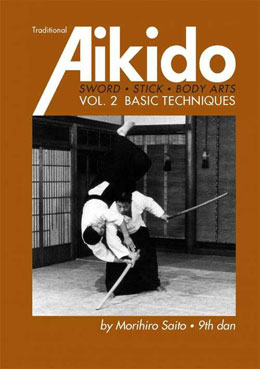BASIC TECHNIQUES (V2)
Sword - Stick - Body Arts

Front page
Contents
Traditional Aikido volume 2 includes:
- Foreword by Morihiro Saito
- Ken, Jo, Taijutsu, and Body Movements
- Before Practice
- Kumitachi
- Uchtachi (defender) and Uketachi (attacker)
Chapter I — Sword Techniques.
- Kumitachi
- 1 — 5 Kumitachi
- Ki Musubi no Tachi
- Kumitachi Variations
- First Kumitachi
- Variation 1 — Kokyu Nage
- Body Method
- Ken method
- Variation 2 — Kokyu Nage
- Body Method
- Ken Method
- Variation 1 — Kokyu Nage
- Second Kumitachi
- Variation 1 — Kote Gaeshi
- Body Method
- Ken method
- Variation 2 — Koshi Nage
- Body Method
- Ken Method
- Variation 1 — Kote Gaeshi
- Third Kumitachi
- Variation 1 — Kote Gaeshi
- Body Method
- Ken method
- Variation 2 — Koshi Nage
- Body Method
- Ken Method
- Variation 1 — Kote Gaeshi
- Forth Kumitachi
- Variation 1 — Rokkyu
- Body Method
- Ken method
- Variation 2 — Koshi Nage
- Body Method
- Ken Method
- Variation 1 — Rokkyu
- Fifth Kumitachi
- Variation 1 — Kokyu Nage
- Body Method
- Ken method
- Variation 2 — Kokyu Nage
- Body Method
- Ken Method
- Variation 1 — Kokyu Nage
- First Kumitachi
- Tachidori
- No. 1 — 10
Chapter II — Jo Techniques.
- Kumi Jo
- No. 1 — 7
- No. 1 — 7
- Jo Tori
- No. 1 — 11
- No. 1 — 11
- Jo and Taijutsu Relationships
- No. 1 — 7
- No. 1 — 7
- Jo and Ken Relatioship
- No. 1 — 10
- Hasso Gaeshi Movement
-Introduction
Traditional Aikido, Volume 2 covers a wide range of weapon techniques and methods. It builds on the weapon basics where Volume 1 leaves off showing more advanced weapon techniques. Aikidoka who have absorbed the material contained in the first volume will find that the techniques of Traditional Aikido, Volume 2 will come as a natural extension of their bodies—or Ken and Jo—as is the case, is in the second volume!
Traditional Aikido volume 2 is the longest of the five volumes containing some 180 pages. It shows the fundamentals of advanced weapon techniques and encourages the reader to go on and develop new techniques. Morihiro Saito Sensei shows the way for instructors to develop the path to “Takemusu Aiki” based on Aiki pinciples. As Morihiro Saito Sensei writes in the foreword in 1973;
“In Aikido, the kumitachi contain body movements based on the principles of Aiki. It is possible at any time during the kumitachi to change to taijutsu. The same truth holds for the kumijo. However, it will be difficult to switch to taijutsu, if one is dependent on the Jo or Ken. Therefore, for easier understanding the explanations have been made using detailed photographs. If the aim of the reader is to instruct Aikido, then this book should be considered necessary.”
“I sincerely hope that the first volume, this book, and the third intended volume will help the reader to broaden his understanding and correctly grasp the principles of Aikido.”
Traditional Aikido, Volume 2 has the following quality features:
- Hardcover with a cotton cover
- High glossy paper
- Thread tied spine
- Dustcover
- 179 pages
- Includes over 650 pictures, many of O-Sensei
Traditional Aikido volume 2 covers the fundamental Hito e mi that’s a basic and fundamental part of Aikido, and one of the keys when it comes to the Kumitachi, Kumijo and in the Riai principle!